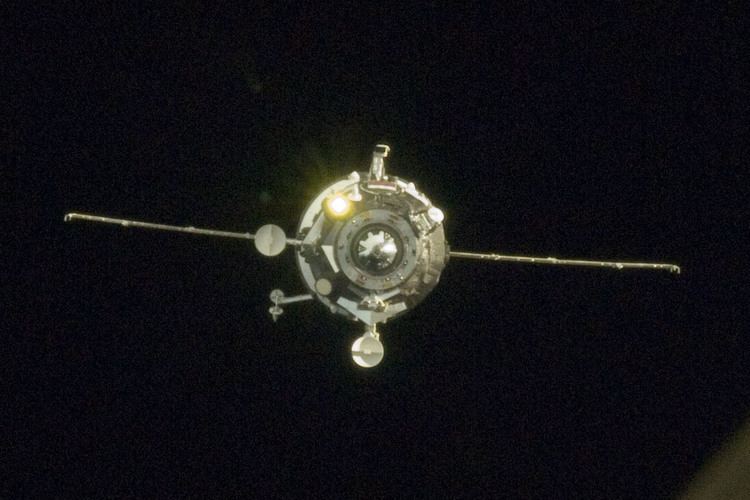Mission type ISS resupply COSPAR ID 2012-060A | Operator Roskosmos SATCAT no. 38975 Manufacturer RKK Energia | |
 | ||
Progress M-17M (Russian: Прогресс М-17М), identified by NASA as Progress 49 or 49P, was a Progress spacecraft used by Roskosmos to resupply the International Space Station during 2012. The seventeenth Progress-M 11F615A60 spacecraft to launch, it had the serial number 417 and was built by RKK Energia. It was the 130th launch to the ISS and the twentieth Russian space launch in 2012. It was also the eleventh mission for the R-7 family of rockets since the beginning of the year.
Contents
On April 15, 2013, Progress M-17M cargo shop undocked from the Space Station. It was disposed six days later and fell into the Pacific Ocean on April 21.
Launch
The spacecraft was launched on time at 07:41:19 UTC on 31 October 2012 from Site 1/5 of the Baikonur Cosmodrome in Kazakhstan, atop a Soyuz-U carrier rocket. It was successfully deployed into low Earth orbit ten minutes later. At the time of launch, the ISS was about 1,550 kilometres (963 mi) ahead of the launch site. At the time of orbital insertion Progress was 3,610 kilometres (2,243 mi) behind the ISS.
Docking
Like the previous mission, Progress M-16M, Progress M-17M used a fast approach profile to the ISS, rendezvousing and docking on its fourth orbit, as opposed to docking about 50 hours after launch on most previous Progress flights. This profile allowed the transportation of critical biological payloads to the ISS. Following testing on Progress flights, the same rendezvous profile was introduced for manned Soyuz flights in 2013 to reduce crew fatigue.
During the rendezvous sequence, the spacecraft performed several burns and rendezvous impulses to enter the proximity of the International Space Station. The KURS system on board the ISS as well as the Progress was activated for navigational purposes. The TV System was activated at a range of 8 kilometres (5.0 mi) as Progress M-17M continued its approach. Aboard the International Space Station, cosmonaut Yuri Malenchenko was standing by at the TORU system as Progress further came close to Space Station to assume manual control over the spacecraft if an issue with the automated docking was to be spotted. The other two cosmonauts Oleg Novitskiy and Evgeny Tarelkin of Expedition 33 members were assisting Malenchenko and acquired engineering footage of the Progress spacecraft.
Progress M-17M initiated its flyaround, upon reaching a distance of 300 metres (980 ft) to Space Station. Once the Flyaround was complete, Progress M-17M entered stationkeeping at a range of 180 metres (590 ft). Russian Mission Controllers in Korolev, just outside Moscow verified that all systems on the spacecraft were performing nominally as well as the alignment with the docking port in the Zvezda Module. With the final command approach issued, Progress fired its thrusters and followed a nominal approach profile. The docking to the Zvezda Module occurred at 13:33 UTC on October 31, 2012, five hours fifty-two minutes after launch. At the time of docking, the space station and the Progress were flying above Bogota, Colombia.
Undocking and decay
Progress M-17M undocked from the Space Station on April 15, 2013. The departure of the spacecraft cleared a docking port on the Zvezda module for the Progress M-19M resupply vehicle which was subsequently launched on April 24. In the following six days, the Progress M-17M spacecraft operated in an autonomous mode conducting a series of scientific experiments under the Radar-Progress project. At the end of the mission, progress M-17M re-entered the Earth's atmosphere and fragments fell into the Pacific Ocean at 15.02 GMT on April 21.
Cargo
Progress M-17M was packed with 1,247 kilograms (2,749 lb) of equipment, food, clothing, life support system gear ("dry" cargo), 683 kilograms (1,506 lb) of propellant to replenish reservoirs that feed the Russian maneuvering thrusters, 420 kilograms (930 lb) of water and 47 kilograms (104 lb) of oxygen and air.
